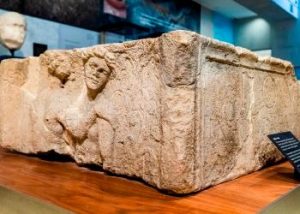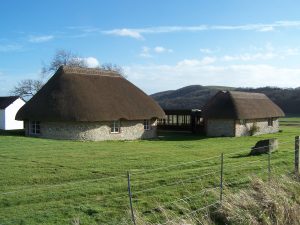Explore the South Downs region’s Roman past by visiting museums
May 1, 2024
 For International Museums Day this month, Anooshka Rawden, Cultural Heritage Lead for the National Park, shines a light on some of the best museums in the area that explore this region’s Roman past.
For International Museums Day this month, Anooshka Rawden, Cultural Heritage Lead for the National Park, shines a light on some of the best museums in the area that explore this region’s Roman past.
I started working in museums at the age of 21, when I volunteered at the British Museum and radiated pure enthusiasm. Museums have been a thread throughout my career since.
My particular spark of interest in museums started as a result of studying Roman visual art.
On International Museums Day, rather selfishly given my own interests, I thought I would highlight some places in and around the South Downs National Park that provide insights into the Roman world, and particularly how it manifested in the Downs.
The Novium Museum
 Boasting archaeological discoveries from across Chichester District, the museum not only holds survivals from the precursor to Chichester today – for the Romans, known as Noviomagus Reginorum – but from across the downland landscape. Here you can see a 4th century AD mosaic floor from Chilgrove (created by a group of highly skilled craftsmen, not adverse to cutting a few corners, in this case laying this beautiful floor on to a poor base of only a few inches of dirty mortar, but hey, it looked good); the fragmented lower half of a small statue of the goddess Fortuna also from Chilgrove, identified by the rudder and globe beside her leg, symbolic of chance and fate; and the remains of a bronze right arm from a Roman statue, discovered in the vicinity of Halnaker, which may have been part of a statue of a god or member of the imperial family, broken down for scrap, to discredit or for ritual reasons.
Boasting archaeological discoveries from across Chichester District, the museum not only holds survivals from the precursor to Chichester today – for the Romans, known as Noviomagus Reginorum – but from across the downland landscape. Here you can see a 4th century AD mosaic floor from Chilgrove (created by a group of highly skilled craftsmen, not adverse to cutting a few corners, in this case laying this beautiful floor on to a poor base of only a few inches of dirty mortar, but hey, it looked good); the fragmented lower half of a small statue of the goddess Fortuna also from Chilgrove, identified by the rudder and globe beside her leg, symbolic of chance and fate; and the remains of a bronze right arm from a Roman statue, discovered in the vicinity of Halnaker, which may have been part of a statue of a god or member of the imperial family, broken down for scrap, to discredit or for ritual reasons.
Visit the Novium Museum: https://www.thenovium.org.uk/
Open Tuesdays – Saturdays. Entry is free.
Chichester Roman Week runs from 27 May – 1 June. Find events here: https://www.thenovium.org.uk/romanweek
Fishbourne Roman Palace
Fishbourne Roman Palace is outstanding – the earliest and largest surviving Roman residence north of the Alps, not only was it a building on a monumental scale, a mark of the Roman arrival, but it communicated key messages, including Rome’s ability to dominate nature and its resources, and thereby magnifying their own power.
More recent research made possible thanks to the archiving of finds from the excavations of the site have revealed more about the Romans and their role in species introduction to Britain – Fishbourne’s gardens were populated with then exotic species, such as semi-domesticated fallow deer (later to die out only to be reintroduced by around 1000AD) and the first rabbits in Britain, demonstrating that although the Romans did much for us today (roads, heating, aqueducts), ecosystem imbalance sits on the flip side…. Visit for the splendour of the mosaics and objects such as a partial fragment of a Roman portrait of a boy, now thought to be the Emperor Nero in childhood; get engrossed in the stories of Roman toilet paper and chickens!
Visit Fishbourne Roman Palace: Fishbourne Roman Palace & Gardens – Sussex Past
Open 7 days a week, April – October. Entry charges apply.
Check out their hot off the press guidebook by Dr. Miles Russell: https://sussexpast.co.uk/product/fishbourne-roman-palace-guidebook-written-by-miles-russell-fsa/
Worthing Museum and Art Gallery

Worthing Museum’s archaeology collections are extensive and rich, with highlight material from the Roman period. This includes the Patching Hoard, dated to the late 460s AD, and therefore enhancing our understanding of Britain after the much-cited ‘letter’ of the Emperor Honorius dated to around AD410, which told the island to “look to their own defence” as the beleaguered emperor had prioritise elsewhere. Other highlights include Roman objects from Chanctonbury Ring, which was utilised as a religious site from the mid 1st century AD, and beautiful objects from Muntham Court, including a 3rd century AD mouthpiece from a musical instrument.
Visit Worthing Museum: https://wtm.uk/museum/
Open Wednesday to Sunday
Bignor Roman Villa
 Dating from the 1st to the 4th century AD and within that undergoing a number of development phases, the Roman villa at Bignor encapsulates a story very resonant to us today – farming, sustainable supply chains and adaptation to new business opportunities. Exploiting landscape resources, including downland grazing and its proximity to Stane Street (which linked Chichester to London), Bignor thrived and its humble origins soon boasted luxurious accommodation, including high quality mosaics floors, with one, featuring the myth of Jupiter (in the guise of an eagle) kidnapping Ganymede, a myth with origins well before the 8th century BC given Homer records the story in his Iliad. It is a story whose young hero came from what is now modern Turkey, translated through the classical ancient Mediterranean, replicated here in the Sussex downland.
Dating from the 1st to the 4th century AD and within that undergoing a number of development phases, the Roman villa at Bignor encapsulates a story very resonant to us today – farming, sustainable supply chains and adaptation to new business opportunities. Exploiting landscape resources, including downland grazing and its proximity to Stane Street (which linked Chichester to London), Bignor thrived and its humble origins soon boasted luxurious accommodation, including high quality mosaics floors, with one, featuring the myth of Jupiter (in the guise of an eagle) kidnapping Ganymede, a myth with origins well before the 8th century BC given Homer records the story in his Iliad. It is a story whose young hero came from what is now modern Turkey, translated through the classical ancient Mediterranean, replicated here in the Sussex downland.
Visit Bignor Roman Villa: Planning your visit | Romanvilla | Bignor (bignorromanvilla.co.uk)
Open Wednesday – Sunday, April – October (open every day in August).
Entry charges apply.
Winchester City Museum
Discover more about Venta Belgarum – known today as Winchester – through a wealth of Roman objects, including the so-called Silkstead Head, a small bronze head of a girl from the first or early second century AD. By the 3rd century, Venta Belgarum was the fifth largest city in Roman Britain, and much like Chichester, was surrounded by an agriculturally rich landscape that gave rise to the ‘villa-economies’ – not just countryside retreats for the wealthy, but functional landed estates where family wealth grew from exports and supply chains – with examples discovered at Rowlands Castle, Holt Down, Stroud, and Chalton. Splendid among the villas of Hampshire, sitting just outside the National Park, Winchester City Museum also boasts beautiful mosaic and fragmented painted wall plaster from Sparsholt Roman Villa.
Visit Winchester City Museum: City Museum, Winchester | Historic Winchester
Entry charges apply.
Enjoy your museum visit! 😊
